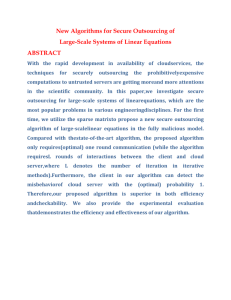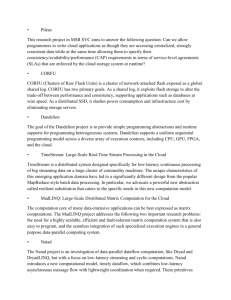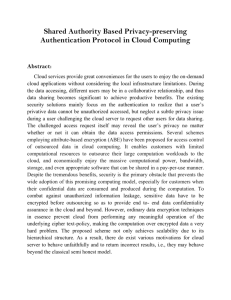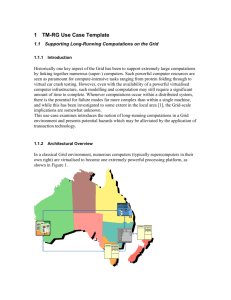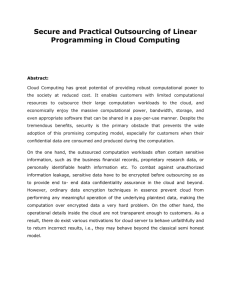SECURE AND PRACTICAL OUTSOURCING OF LINEAR
advertisement
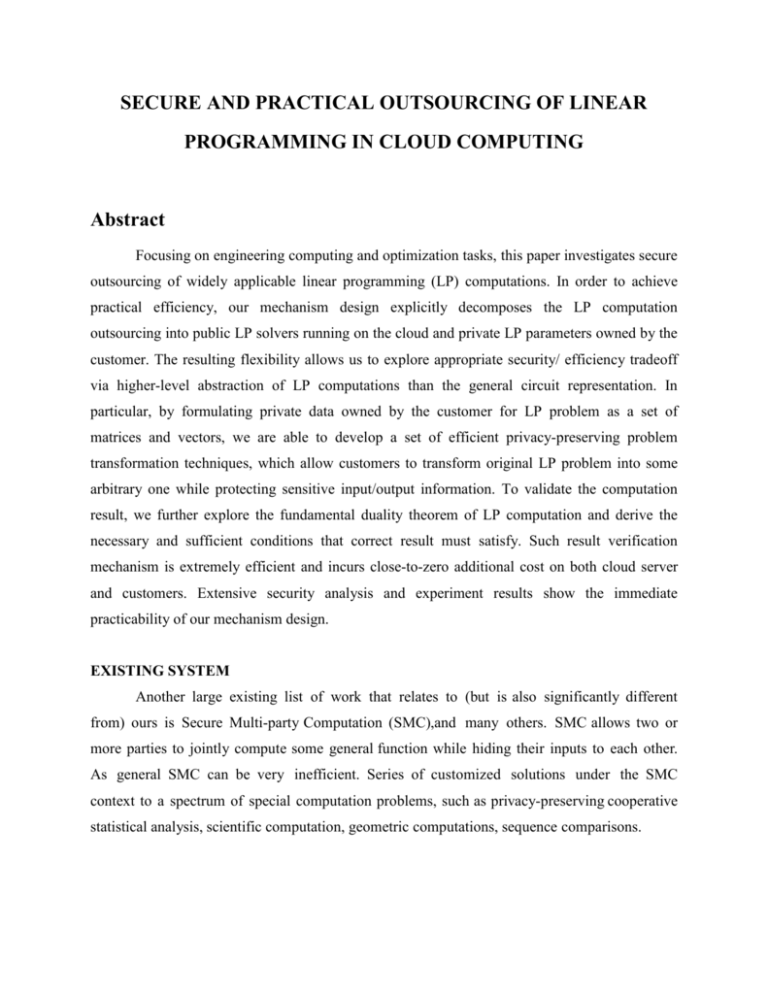
SECURE AND PRACTICAL OUTSOURCING OF LINEAR PROGRAMMING IN CLOUD COMPUTING Abstract Focusing on engineering computing and optimization tasks, this paper investigates secure outsourcing of widely applicable linear programming (LP) computations. In order to achieve practical efficiency, our mechanism design explicitly decomposes the LP computation outsourcing into public LP solvers running on the cloud and private LP parameters owned by the customer. The resulting flexibility allows us to explore appropriate security/ efficiency tradeoff via higher-level abstraction of LP computations than the general circuit representation. In particular, by formulating private data owned by the customer for LP problem as a set of matrices and vectors, we are able to develop a set of efficient privacy-preserving problem transformation techniques, which allow customers to transform original LP problem into some arbitrary one while protecting sensitive input/output information. To validate the computation result, we further explore the fundamental duality theorem of LP computation and derive the necessary and sufficient conditions that correct result must satisfy. Such result verification mechanism is extremely efficient and incurs close-to-zero additional cost on both cloud server and customers. Extensive security analysis and experiment results show the immediate practicability of our mechanism design. EXISTING SYSTEM Another large existing list of work that relates to (but is also significantly different from) ours is Secure Multi-party Computation (SMC),and many others. SMC allows two or more parties to jointly compute some general function while hiding their inputs to each other. As general SMC can be very inefficient. Series of customized solutions under the SMC context to a spectrum of special computation problems, such as privacy-preserving cooperative statistical analysis, scientific computation, geometric computations, sequence comparisons. PROPOSED SYSTEM Practically efficient mechanisms for secure outsourcing of linear programming (LP) computations. Linear programming is an algorithmic and computational tool which captures the first order effects of various system parameters that should be optimized, and is essential to engineering optimization. It has been widely used in various engineering disciplines that analyze and optimize real-world systems, such as packet routing, flow control, power management of data centers. Because LP computations require a substantial amount of computational power and usually involve confidential data, we propose to explicitly decompose the LP computation outsourcing into public LP solvers running on the cloud and private LP parameters owned by the customer. The flexibility of such decomposition allows us to explore higher-level abstraction of LP computations than the general circuit representation for the practical efficiency. Advantage: Security is the primary obstacle that prevents the wide adoption of this promising computing model, especially for customers when their confidential data are consumed and produced during the computation. SYSTEM MODELS HARDWARE REQUIREMENT CPU type : Intel Pentium 4 Clock speed : 3.0 GHz Ram size : 512 MB Hard disk capacity : 40 GB Monitor type : 15 Inch color monitor Keyboard type : internet keyboard SOFTWARE REQUIREMENT O p e r a t i n g S ys t e m : A n d r o i d Language : JAVA Back End : SQLite Documentation : Ms-Office MODULES Customer Send data with LP Mechanism Design Framework Key Generation Problem Encryption Proof Generation Key Decryption Report MODULE DESCRIPTION Customer Customer can use this computational tool which captures the first order effects of various system parameters that should be optimized, and is essential to engineering optimization. It has been widely used in various engineering disciplines that analyze and optimize real-world systems, such as packet routing, flow control, power management of data centers. Send data with LP Such a method of result validation can be very efficient and incurs close-to-zero additional overhead on both customer and cloud server. With correctly verified result, customer can use the secret transformation to map back the desired solution for his original LP problem Mechanism Design Framework Apply this problem transformation for mechanism design. The general framework is adopted from a generic approach , while our instantiation is completely different and novel. In this framework, the process on cloud server can be represented by algorithm ProofGen and the process on customer can be organized. Key Generation This is a randomized key generation algorithm which takes a system security parameter k, and returns a secret key K that is used later by customer to encrypt the target LP problem. Problem Encryption This algorithm encrypts the input tuple Φ into Φk with the secret key K. According to problem transformation, the encrypted input Φk has the same form as Φ, and thus defines the problem to be solved in the cloud. Proof Generation This algorithm augments a generic solver that solves the problem Φ K to produce both the output y and a proof ┌. The output y later decrypts to x, and ┌ is used later by the customer to verify the correctness of y or x. Key Description The mechanism must produce an output that can be decrypted and verified successfully by the customer. Report Finally all process generated by the user. SYSTEM FLOW DIAGRAM LP problem Φ LP problem Φk Encrypt Cloud server Customer Secret key Verify and decrypt Answer to Φ Answer to Φk Proof ┌ CONCLUSION We formalize the problem of securely outsourcing LP computations in cloud computing, and provide such a practical mechanism design which fulfills input/output privacy, cheating resilience, and efficiency. By explicitly decomposing LP computation outsourcing into public LP solvers and private data, our mechanism design is able to explore appropriate security/efficiency tradeoffs via higher level LP computation than the general circuit representation. We develop problem transformation techniques that enable customers to secretly transform the original LP into some arbitrary one while protecting sensitive input/output information. We also investigate duality theorem and derive a set of necessary and sufficient condition for result verification. Such a cheating resilience design can be bundled in the overall mechanism with close-to-zero additional overhead. Both security analysis and experiment results demonstrate the immediate practicality of the proposed mechanism.
